Managerial Leadership in Asia: Change Management and Diversity Report
VerifiedAdded on 2022/10/14
|19
|5325
|423
Report
AI Summary
This report delves into the nuances of managerial leadership in Asia, examining critical aspects such as contextual intelligence, leader-follower relationships, and diversity management within business organizations. It begins by providing an overview of the evolution of managerial leadership in Asia, highlighting the influence of cultural values and the shift from traditional to Western-influenced practices. The report then explores contextual intelligence, defining its role in analyzing and adapting to dynamic environments. It further examines the empirical origins of contextual intelligence, its relationship with experience, and its practical application in diagnosing contexts. Moreover, the report addresses the significance of leader-follower relationships, and the importance of diversity management in the workplace. It discusses the different types of diversity management, the characteristics of an effective diversity program, and best practices for managing diversity. The report concludes by providing a comprehensive analysis of the subject matter, offering valuable insights into the complexities of leadership in the Asian context.
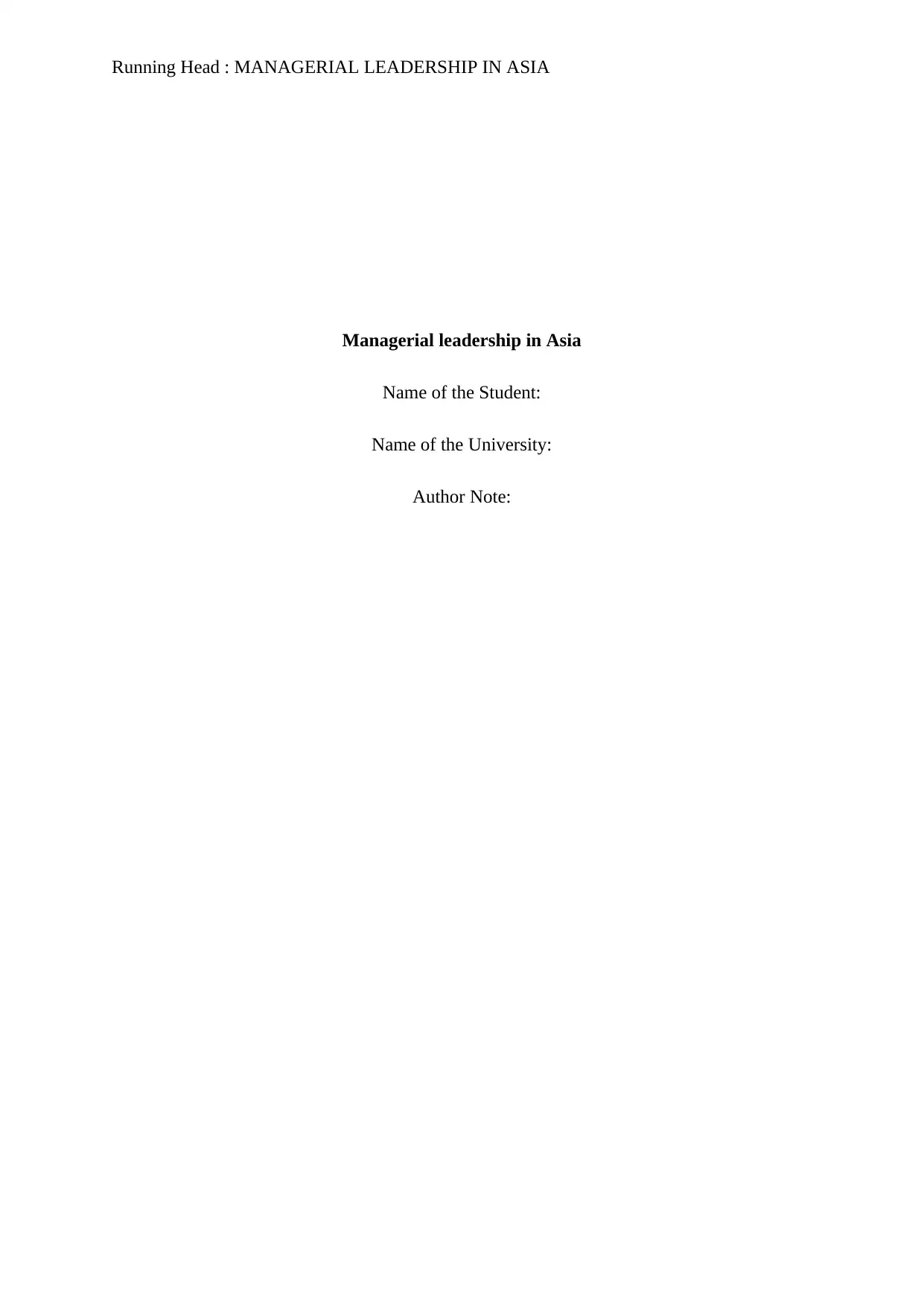
Running Head : MANAGERIAL LEADERSHIP IN ASIA
Managerial leadership in Asia
Name of the Student:
Name of the University:
Author Note:
Managerial leadership in Asia
Name of the Student:
Name of the University:
Author Note:
Paraphrase This Document
Need a fresh take? Get an instant paraphrase of this document with our AI Paraphraser
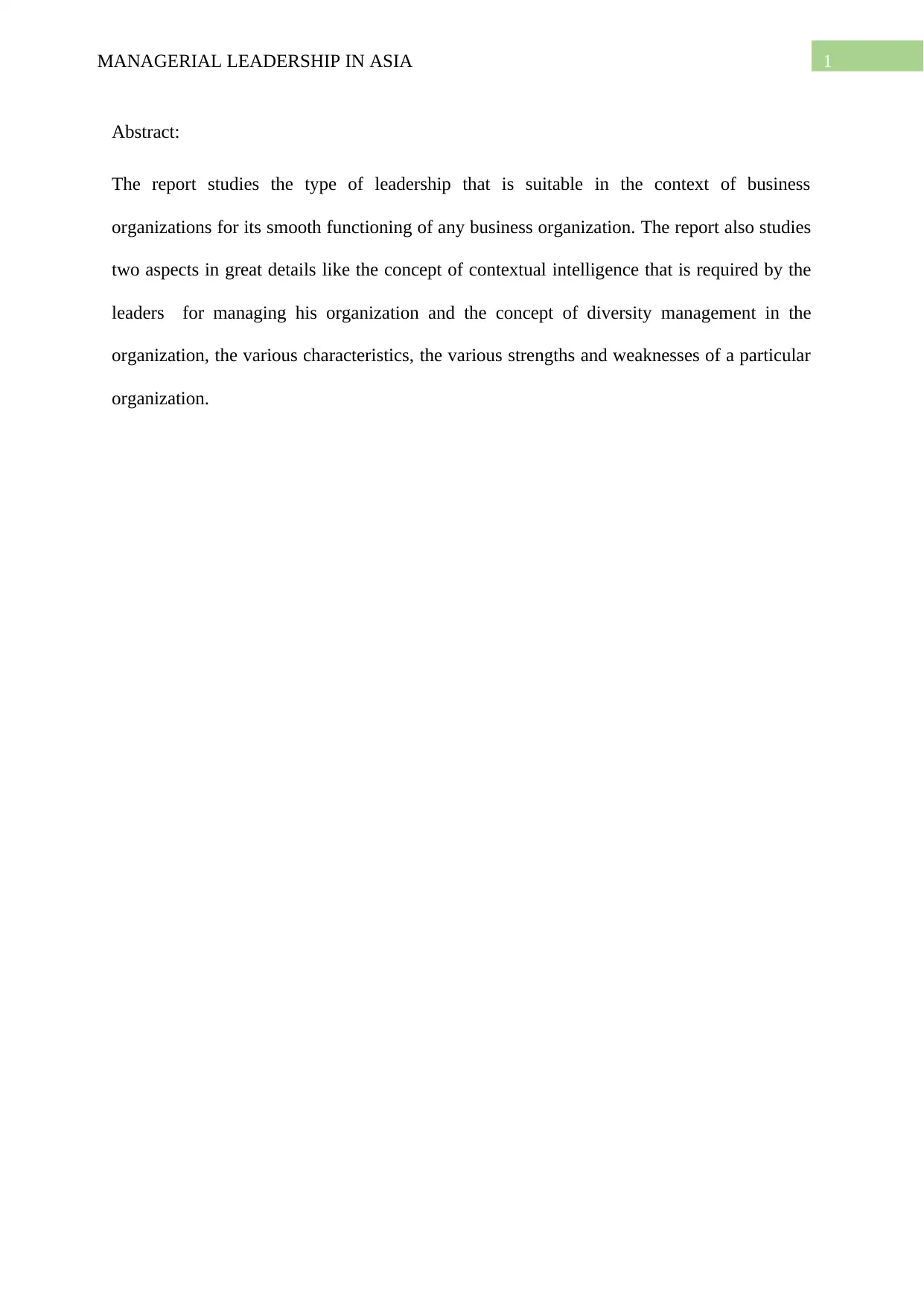
1MANAGERIAL LEADERSHIP IN ASIA
Abstract:
The report studies the type of leadership that is suitable in the context of business
organizations for its smooth functioning of any business organization. The report also studies
two aspects in great details like the concept of contextual intelligence that is required by the
leaders for managing his organization and the concept of diversity management in the
organization, the various characteristics, the various strengths and weaknesses of a particular
organization.
Abstract:
The report studies the type of leadership that is suitable in the context of business
organizations for its smooth functioning of any business organization. The report also studies
two aspects in great details like the concept of contextual intelligence that is required by the
leaders for managing his organization and the concept of diversity management in the
organization, the various characteristics, the various strengths and weaknesses of a particular
organization.
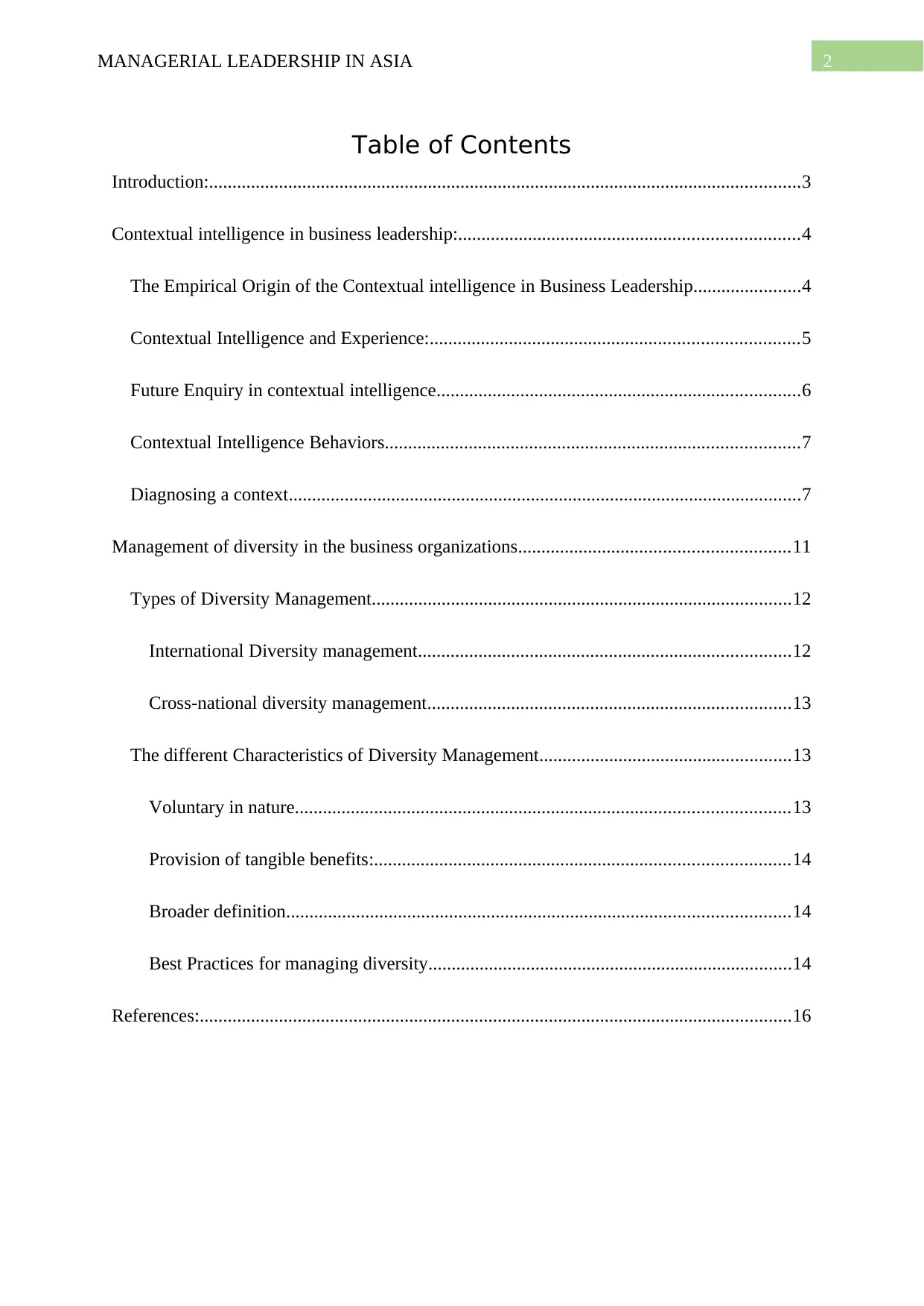
2MANAGERIAL LEADERSHIP IN ASIA
Table of Contents
Introduction:...............................................................................................................................3
Contextual intelligence in business leadership:.........................................................................4
The Empirical Origin of the Contextual intelligence in Business Leadership.......................4
Contextual Intelligence and Experience:...............................................................................5
Future Enquiry in contextual intelligence..............................................................................6
Contextual Intelligence Behaviors.........................................................................................7
Diagnosing a context..............................................................................................................7
Management of diversity in the business organizations..........................................................11
Types of Diversity Management..........................................................................................12
International Diversity management................................................................................12
Cross-national diversity management..............................................................................13
The different Characteristics of Diversity Management......................................................13
Voluntary in nature..........................................................................................................13
Provision of tangible benefits:.........................................................................................14
Broader definition............................................................................................................14
Best Practices for managing diversity..............................................................................14
References:...............................................................................................................................16
Table of Contents
Introduction:...............................................................................................................................3
Contextual intelligence in business leadership:.........................................................................4
The Empirical Origin of the Contextual intelligence in Business Leadership.......................4
Contextual Intelligence and Experience:...............................................................................5
Future Enquiry in contextual intelligence..............................................................................6
Contextual Intelligence Behaviors.........................................................................................7
Diagnosing a context..............................................................................................................7
Management of diversity in the business organizations..........................................................11
Types of Diversity Management..........................................................................................12
International Diversity management................................................................................12
Cross-national diversity management..............................................................................13
The different Characteristics of Diversity Management......................................................13
Voluntary in nature..........................................................................................................13
Provision of tangible benefits:.........................................................................................14
Broader definition............................................................................................................14
Best Practices for managing diversity..............................................................................14
References:...............................................................................................................................16
⊘ This is a preview!⊘
Do you want full access?
Subscribe today to unlock all pages.

Trusted by 1+ million students worldwide
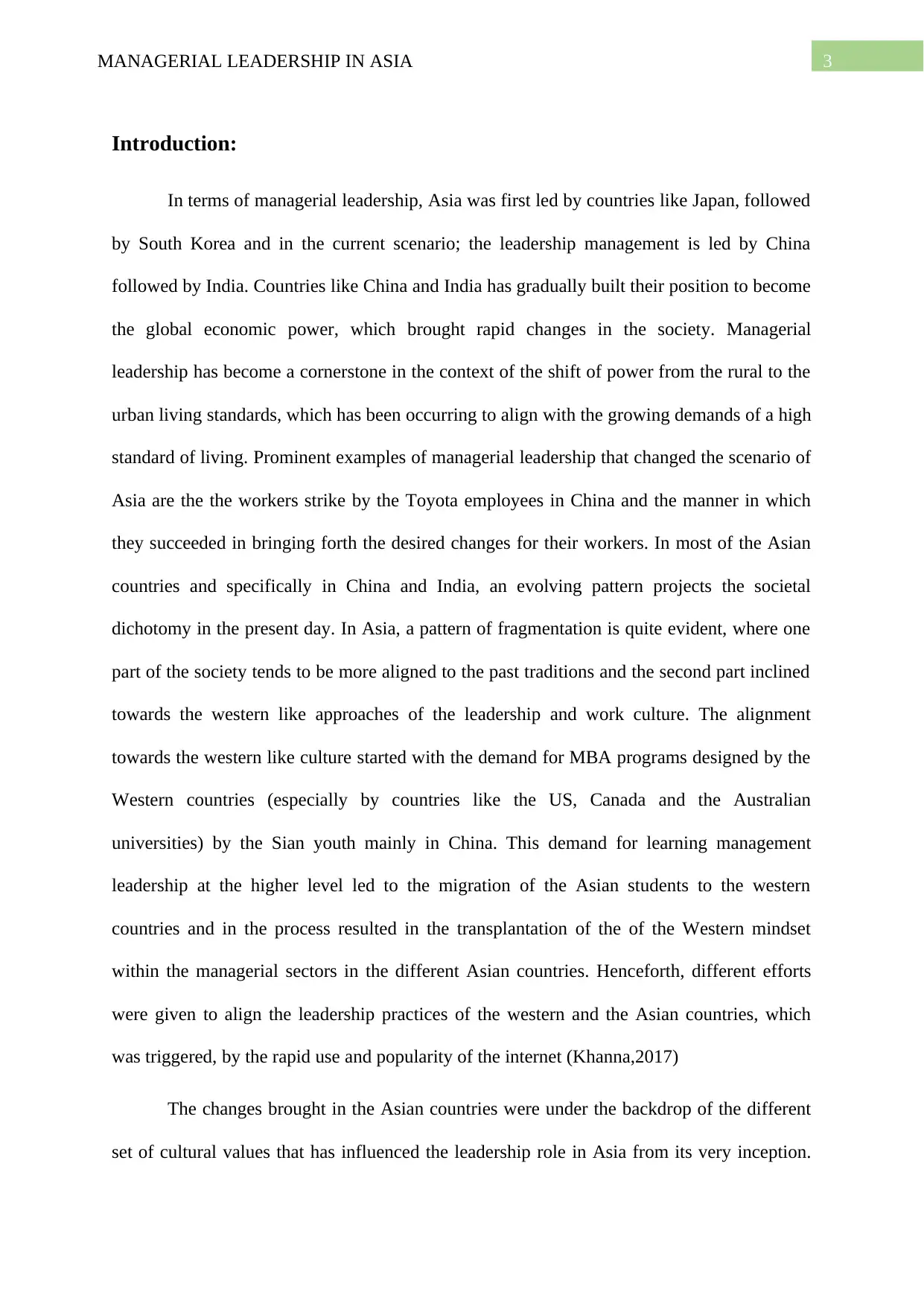
3MANAGERIAL LEADERSHIP IN ASIA
Introduction:
In terms of managerial leadership, Asia was first led by countries like Japan, followed
by South Korea and in the current scenario; the leadership management is led by China
followed by India. Countries like China and India has gradually built their position to become
the global economic power, which brought rapid changes in the society. Managerial
leadership has become a cornerstone in the context of the shift of power from the rural to the
urban living standards, which has been occurring to align with the growing demands of a high
standard of living. Prominent examples of managerial leadership that changed the scenario of
Asia are the the workers strike by the Toyota employees in China and the manner in which
they succeeded in bringing forth the desired changes for their workers. In most of the Asian
countries and specifically in China and India, an evolving pattern projects the societal
dichotomy in the present day. In Asia, a pattern of fragmentation is quite evident, where one
part of the society tends to be more aligned to the past traditions and the second part inclined
towards the western like approaches of the leadership and work culture. The alignment
towards the western like culture started with the demand for MBA programs designed by the
Western countries (especially by countries like the US, Canada and the Australian
universities) by the Sian youth mainly in China. This demand for learning management
leadership at the higher level led to the migration of the Asian students to the western
countries and in the process resulted in the transplantation of the of the Western mindset
within the managerial sectors in the different Asian countries. Henceforth, different efforts
were given to align the leadership practices of the western and the Asian countries, which
was triggered, by the rapid use and popularity of the internet (Khanna,2017)
The changes brought in the Asian countries were under the backdrop of the different
set of cultural values that has influenced the leadership role in Asia from its very inception.
Introduction:
In terms of managerial leadership, Asia was first led by countries like Japan, followed
by South Korea and in the current scenario; the leadership management is led by China
followed by India. Countries like China and India has gradually built their position to become
the global economic power, which brought rapid changes in the society. Managerial
leadership has become a cornerstone in the context of the shift of power from the rural to the
urban living standards, which has been occurring to align with the growing demands of a high
standard of living. Prominent examples of managerial leadership that changed the scenario of
Asia are the the workers strike by the Toyota employees in China and the manner in which
they succeeded in bringing forth the desired changes for their workers. In most of the Asian
countries and specifically in China and India, an evolving pattern projects the societal
dichotomy in the present day. In Asia, a pattern of fragmentation is quite evident, where one
part of the society tends to be more aligned to the past traditions and the second part inclined
towards the western like approaches of the leadership and work culture. The alignment
towards the western like culture started with the demand for MBA programs designed by the
Western countries (especially by countries like the US, Canada and the Australian
universities) by the Sian youth mainly in China. This demand for learning management
leadership at the higher level led to the migration of the Asian students to the western
countries and in the process resulted in the transplantation of the of the Western mindset
within the managerial sectors in the different Asian countries. Henceforth, different efforts
were given to align the leadership practices of the western and the Asian countries, which
was triggered, by the rapid use and popularity of the internet (Khanna,2017)
The changes brought in the Asian countries were under the backdrop of the different
set of cultural values that has influenced the leadership role in Asia from its very inception.
Paraphrase This Document
Need a fresh take? Get an instant paraphrase of this document with our AI Paraphraser
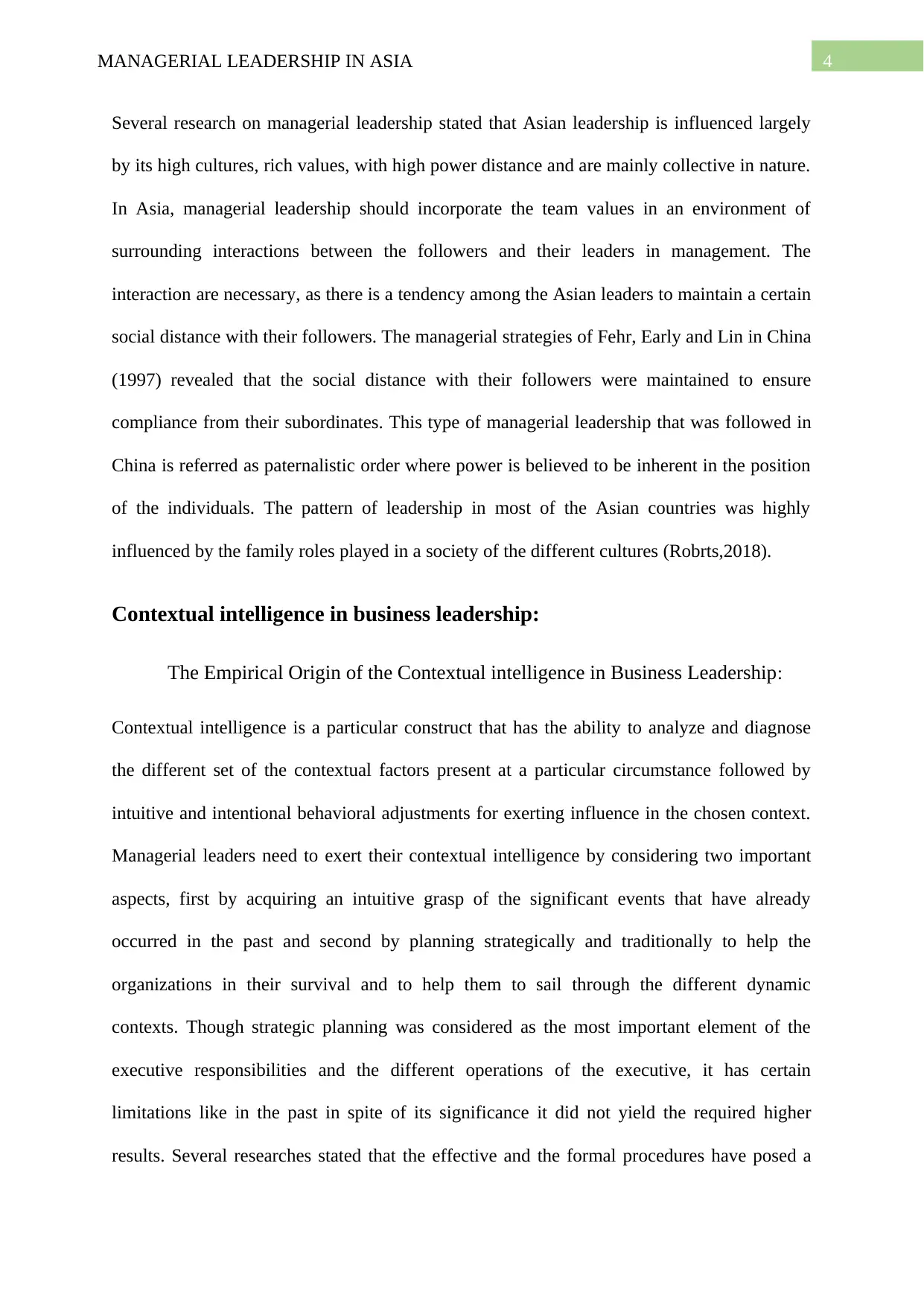
4MANAGERIAL LEADERSHIP IN ASIA
Several research on managerial leadership stated that Asian leadership is influenced largely
by its high cultures, rich values, with high power distance and are mainly collective in nature.
In Asia, managerial leadership should incorporate the team values in an environment of
surrounding interactions between the followers and their leaders in management. The
interaction are necessary, as there is a tendency among the Asian leaders to maintain a certain
social distance with their followers. The managerial strategies of Fehr, Early and Lin in China
(1997) revealed that the social distance with their followers were maintained to ensure
compliance from their subordinates. This type of managerial leadership that was followed in
China is referred as paternalistic order where power is believed to be inherent in the position
of the individuals. The pattern of leadership in most of the Asian countries was highly
influenced by the family roles played in a society of the different cultures (Robrts,2018).
Contextual intelligence in business leadership:
The Empirical Origin of the Contextual intelligence in Business Leadership:
Contextual intelligence is a particular construct that has the ability to analyze and diagnose
the different set of the contextual factors present at a particular circumstance followed by
intuitive and intentional behavioral adjustments for exerting influence in the chosen context.
Managerial leaders need to exert their contextual intelligence by considering two important
aspects, first by acquiring an intuitive grasp of the significant events that have already
occurred in the past and second by planning strategically and traditionally to help the
organizations in their survival and to help them to sail through the different dynamic
contexts. Though strategic planning was considered as the most important element of the
executive responsibilities and the different operations of the executive, it has certain
limitations like in the past in spite of its significance it did not yield the required higher
results. Several researches stated that the effective and the formal procedures have posed a
Several research on managerial leadership stated that Asian leadership is influenced largely
by its high cultures, rich values, with high power distance and are mainly collective in nature.
In Asia, managerial leadership should incorporate the team values in an environment of
surrounding interactions between the followers and their leaders in management. The
interaction are necessary, as there is a tendency among the Asian leaders to maintain a certain
social distance with their followers. The managerial strategies of Fehr, Early and Lin in China
(1997) revealed that the social distance with their followers were maintained to ensure
compliance from their subordinates. This type of managerial leadership that was followed in
China is referred as paternalistic order where power is believed to be inherent in the position
of the individuals. The pattern of leadership in most of the Asian countries was highly
influenced by the family roles played in a society of the different cultures (Robrts,2018).
Contextual intelligence in business leadership:
The Empirical Origin of the Contextual intelligence in Business Leadership:
Contextual intelligence is a particular construct that has the ability to analyze and diagnose
the different set of the contextual factors present at a particular circumstance followed by
intuitive and intentional behavioral adjustments for exerting influence in the chosen context.
Managerial leaders need to exert their contextual intelligence by considering two important
aspects, first by acquiring an intuitive grasp of the significant events that have already
occurred in the past and second by planning strategically and traditionally to help the
organizations in their survival and to help them to sail through the different dynamic
contexts. Though strategic planning was considered as the most important element of the
executive responsibilities and the different operations of the executive, it has certain
limitations like in the past in spite of its significance it did not yield the required higher
results. Several researches stated that the effective and the formal procedures have posed a
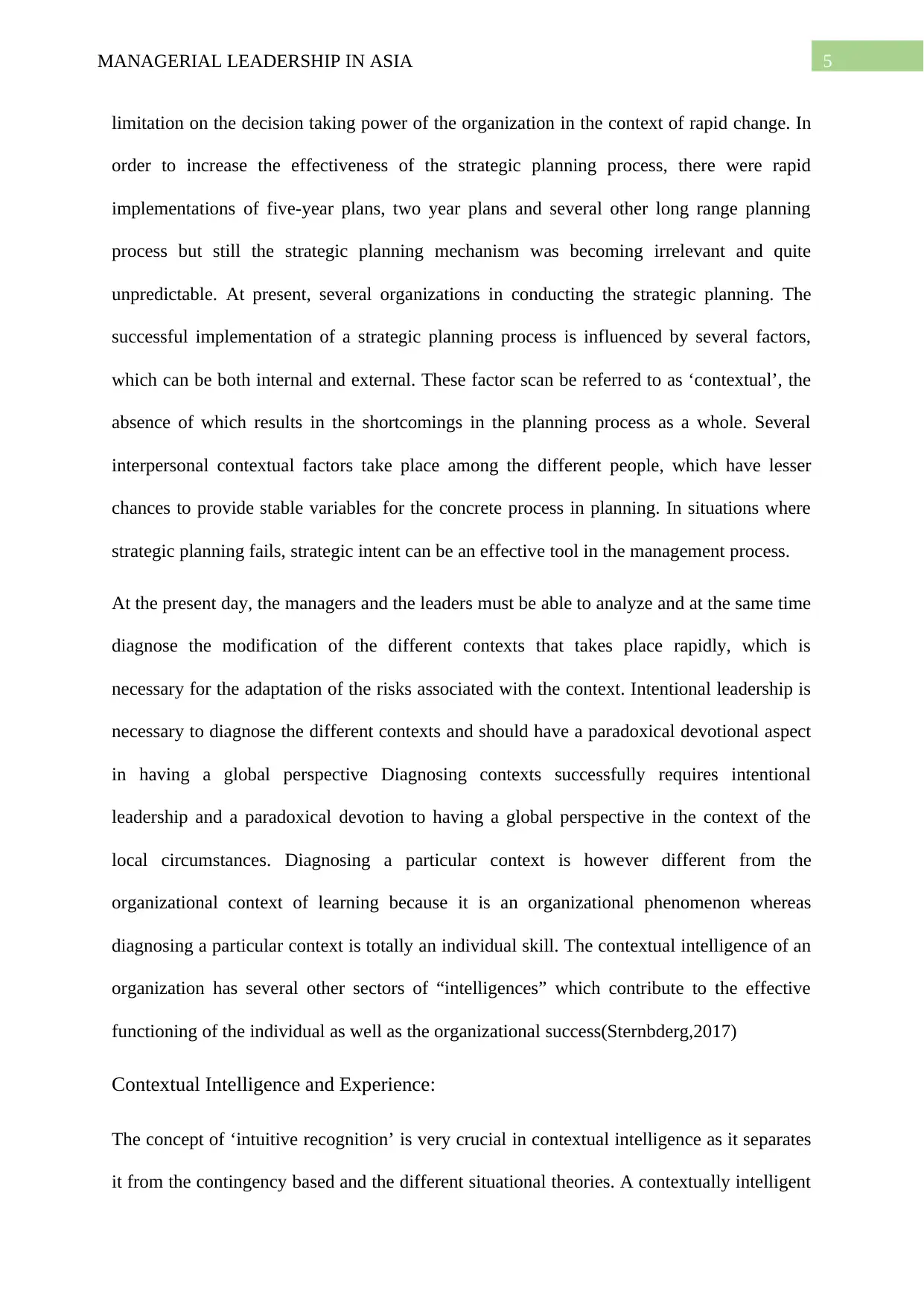
5MANAGERIAL LEADERSHIP IN ASIA
limitation on the decision taking power of the organization in the context of rapid change. In
order to increase the effectiveness of the strategic planning process, there were rapid
implementations of five-year plans, two year plans and several other long range planning
process but still the strategic planning mechanism was becoming irrelevant and quite
unpredictable. At present, several organizations in conducting the strategic planning. The
successful implementation of a strategic planning process is influenced by several factors,
which can be both internal and external. These factor scan be referred to as ‘contextual’, the
absence of which results in the shortcomings in the planning process as a whole. Several
interpersonal contextual factors take place among the different people, which have lesser
chances to provide stable variables for the concrete process in planning. In situations where
strategic planning fails, strategic intent can be an effective tool in the management process.
At the present day, the managers and the leaders must be able to analyze and at the same time
diagnose the modification of the different contexts that takes place rapidly, which is
necessary for the adaptation of the risks associated with the context. Intentional leadership is
necessary to diagnose the different contexts and should have a paradoxical devotional aspect
in having a global perspective Diagnosing contexts successfully requires intentional
leadership and a paradoxical devotion to having a global perspective in the context of the
local circumstances. Diagnosing a particular context is however different from the
organizational context of learning because it is an organizational phenomenon whereas
diagnosing a particular context is totally an individual skill. The contextual intelligence of an
organization has several other sectors of “intelligences” which contribute to the effective
functioning of the individual as well as the organizational success(Sternbderg,2017)
Contextual Intelligence and Experience:
The concept of ‘intuitive recognition’ is very crucial in contextual intelligence as it separates
it from the contingency based and the different situational theories. A contextually intelligent
limitation on the decision taking power of the organization in the context of rapid change. In
order to increase the effectiveness of the strategic planning process, there were rapid
implementations of five-year plans, two year plans and several other long range planning
process but still the strategic planning mechanism was becoming irrelevant and quite
unpredictable. At present, several organizations in conducting the strategic planning. The
successful implementation of a strategic planning process is influenced by several factors,
which can be both internal and external. These factor scan be referred to as ‘contextual’, the
absence of which results in the shortcomings in the planning process as a whole. Several
interpersonal contextual factors take place among the different people, which have lesser
chances to provide stable variables for the concrete process in planning. In situations where
strategic planning fails, strategic intent can be an effective tool in the management process.
At the present day, the managers and the leaders must be able to analyze and at the same time
diagnose the modification of the different contexts that takes place rapidly, which is
necessary for the adaptation of the risks associated with the context. Intentional leadership is
necessary to diagnose the different contexts and should have a paradoxical devotional aspect
in having a global perspective Diagnosing contexts successfully requires intentional
leadership and a paradoxical devotion to having a global perspective in the context of the
local circumstances. Diagnosing a particular context is however different from the
organizational context of learning because it is an organizational phenomenon whereas
diagnosing a particular context is totally an individual skill. The contextual intelligence of an
organization has several other sectors of “intelligences” which contribute to the effective
functioning of the individual as well as the organizational success(Sternbderg,2017)
Contextual Intelligence and Experience:
The concept of ‘intuitive recognition’ is very crucial in contextual intelligence as it separates
it from the contingency based and the different situational theories. A contextually intelligent
⊘ This is a preview!⊘
Do you want full access?
Subscribe today to unlock all pages.

Trusted by 1+ million students worldwide
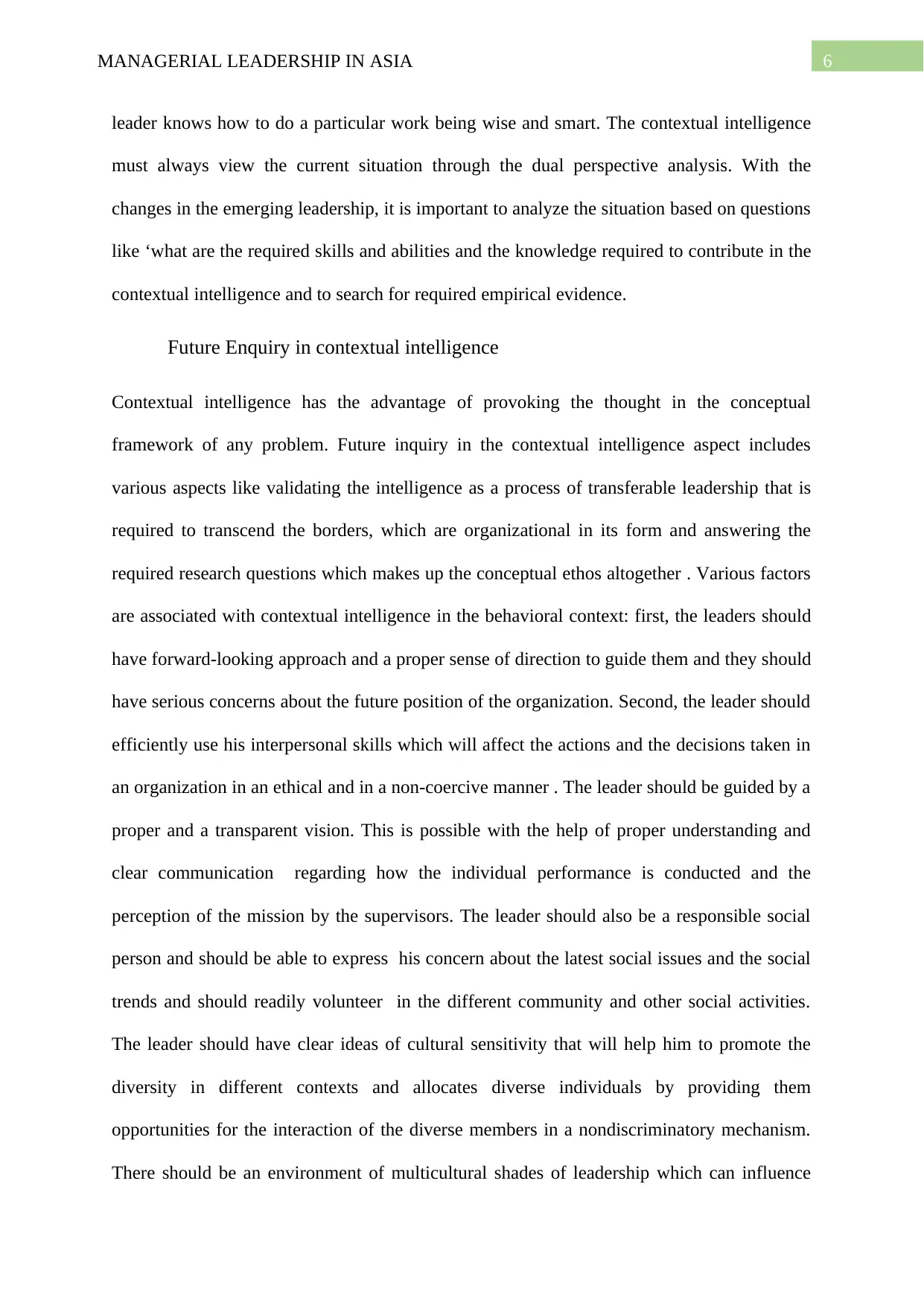
6MANAGERIAL LEADERSHIP IN ASIA
leader knows how to do a particular work being wise and smart. The contextual intelligence
must always view the current situation through the dual perspective analysis. With the
changes in the emerging leadership, it is important to analyze the situation based on questions
like ‘what are the required skills and abilities and the knowledge required to contribute in the
contextual intelligence and to search for required empirical evidence.
Future Enquiry in contextual intelligence
Contextual intelligence has the advantage of provoking the thought in the conceptual
framework of any problem. Future inquiry in the contextual intelligence aspect includes
various aspects like validating the intelligence as a process of transferable leadership that is
required to transcend the borders, which are organizational in its form and answering the
required research questions which makes up the conceptual ethos altogether . Various factors
are associated with contextual intelligence in the behavioral context: first, the leaders should
have forward-looking approach and a proper sense of direction to guide them and they should
have serious concerns about the future position of the organization. Second, the leader should
efficiently use his interpersonal skills which will affect the actions and the decisions taken in
an organization in an ethical and in a non-coercive manner . The leader should be guided by a
proper and a transparent vision. This is possible with the help of proper understanding and
clear communication regarding how the individual performance is conducted and the
perception of the mission by the supervisors. The leader should also be a responsible social
person and should be able to express his concern about the latest social issues and the social
trends and should readily volunteer in the different community and other social activities.
The leader should have clear ideas of cultural sensitivity that will help him to promote the
diversity in different contexts and allocates diverse individuals by providing them
opportunities for the interaction of the diverse members in a nondiscriminatory mechanism.
There should be an environment of multicultural shades of leadership which can influence
leader knows how to do a particular work being wise and smart. The contextual intelligence
must always view the current situation through the dual perspective analysis. With the
changes in the emerging leadership, it is important to analyze the situation based on questions
like ‘what are the required skills and abilities and the knowledge required to contribute in the
contextual intelligence and to search for required empirical evidence.
Future Enquiry in contextual intelligence
Contextual intelligence has the advantage of provoking the thought in the conceptual
framework of any problem. Future inquiry in the contextual intelligence aspect includes
various aspects like validating the intelligence as a process of transferable leadership that is
required to transcend the borders, which are organizational in its form and answering the
required research questions which makes up the conceptual ethos altogether . Various factors
are associated with contextual intelligence in the behavioral context: first, the leaders should
have forward-looking approach and a proper sense of direction to guide them and they should
have serious concerns about the future position of the organization. Second, the leader should
efficiently use his interpersonal skills which will affect the actions and the decisions taken in
an organization in an ethical and in a non-coercive manner . The leader should be guided by a
proper and a transparent vision. This is possible with the help of proper understanding and
clear communication regarding how the individual performance is conducted and the
perception of the mission by the supervisors. The leader should also be a responsible social
person and should be able to express his concern about the latest social issues and the social
trends and should readily volunteer in the different community and other social activities.
The leader should have clear ideas of cultural sensitivity that will help him to promote the
diversity in different contexts and allocates diverse individuals by providing them
opportunities for the interaction of the diverse members in a nondiscriminatory mechanism.
There should be an environment of multicultural shades of leadership which can influence
Paraphrase This Document
Need a fresh take? Get an instant paraphrase of this document with our AI Paraphraser
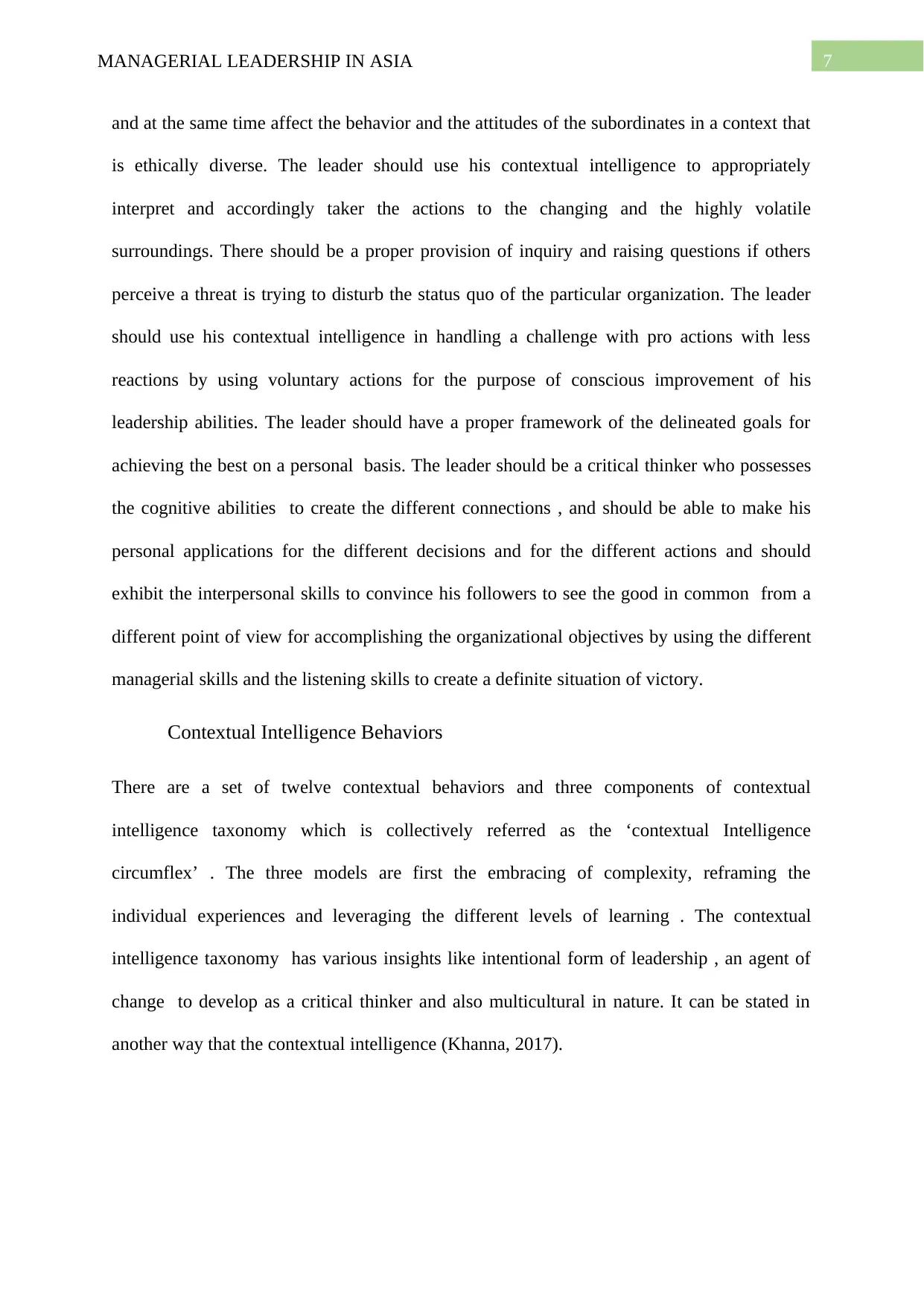
7MANAGERIAL LEADERSHIP IN ASIA
and at the same time affect the behavior and the attitudes of the subordinates in a context that
is ethically diverse. The leader should use his contextual intelligence to appropriately
interpret and accordingly taker the actions to the changing and the highly volatile
surroundings. There should be a proper provision of inquiry and raising questions if others
perceive a threat is trying to disturb the status quo of the particular organization. The leader
should use his contextual intelligence in handling a challenge with pro actions with less
reactions by using voluntary actions for the purpose of conscious improvement of his
leadership abilities. The leader should have a proper framework of the delineated goals for
achieving the best on a personal basis. The leader should be a critical thinker who possesses
the cognitive abilities to create the different connections , and should be able to make his
personal applications for the different decisions and for the different actions and should
exhibit the interpersonal skills to convince his followers to see the good in common from a
different point of view for accomplishing the organizational objectives by using the different
managerial skills and the listening skills to create a definite situation of victory.
Contextual Intelligence Behaviors
There are a set of twelve contextual behaviors and three components of contextual
intelligence taxonomy which is collectively referred as the ‘contextual Intelligence
circumflex’ . The three models are first the embracing of complexity, reframing the
individual experiences and leveraging the different levels of learning . The contextual
intelligence taxonomy has various insights like intentional form of leadership , an agent of
change to develop as a critical thinker and also multicultural in nature. It can be stated in
another way that the contextual intelligence (Khanna, 2017).
and at the same time affect the behavior and the attitudes of the subordinates in a context that
is ethically diverse. The leader should use his contextual intelligence to appropriately
interpret and accordingly taker the actions to the changing and the highly volatile
surroundings. There should be a proper provision of inquiry and raising questions if others
perceive a threat is trying to disturb the status quo of the particular organization. The leader
should use his contextual intelligence in handling a challenge with pro actions with less
reactions by using voluntary actions for the purpose of conscious improvement of his
leadership abilities. The leader should have a proper framework of the delineated goals for
achieving the best on a personal basis. The leader should be a critical thinker who possesses
the cognitive abilities to create the different connections , and should be able to make his
personal applications for the different decisions and for the different actions and should
exhibit the interpersonal skills to convince his followers to see the good in common from a
different point of view for accomplishing the organizational objectives by using the different
managerial skills and the listening skills to create a definite situation of victory.
Contextual Intelligence Behaviors
There are a set of twelve contextual behaviors and three components of contextual
intelligence taxonomy which is collectively referred as the ‘contextual Intelligence
circumflex’ . The three models are first the embracing of complexity, reframing the
individual experiences and leveraging the different levels of learning . The contextual
intelligence taxonomy has various insights like intentional form of leadership , an agent of
change to develop as a critical thinker and also multicultural in nature. It can be stated in
another way that the contextual intelligence (Khanna, 2017).
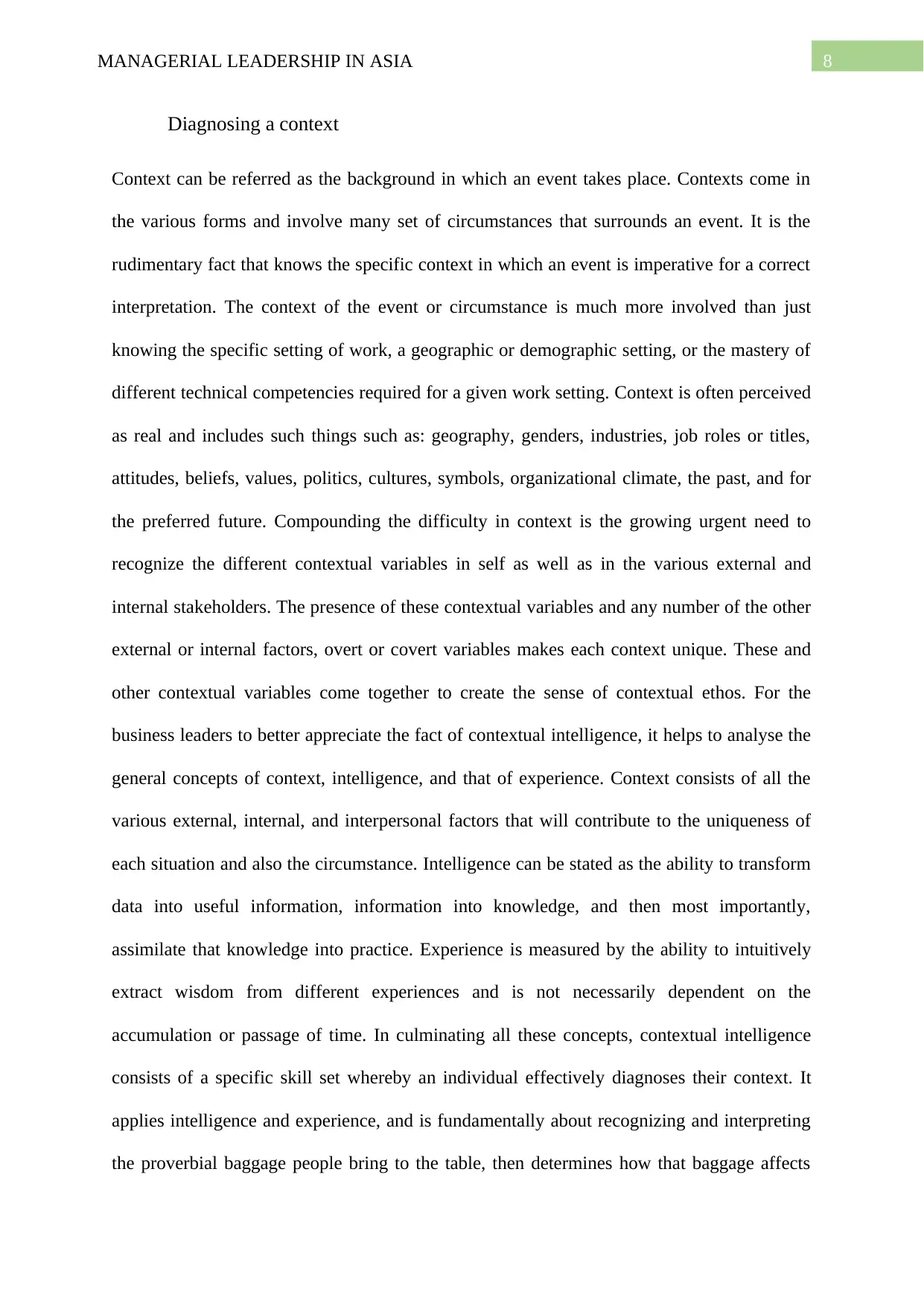
8MANAGERIAL LEADERSHIP IN ASIA
Diagnosing a context
Context can be referred as the background in which an event takes place. Contexts come in
the various forms and involve many set of circumstances that surrounds an event. It is the
rudimentary fact that knows the specific context in which an event is imperative for a correct
interpretation. The context of the event or circumstance is much more involved than just
knowing the specific setting of work, a geographic or demographic setting, or the mastery of
different technical competencies required for a given work setting. Context is often perceived
as real and includes such things such as: geography, genders, industries, job roles or titles,
attitudes, beliefs, values, politics, cultures, symbols, organizational climate, the past, and for
the preferred future. Compounding the difficulty in context is the growing urgent need to
recognize the different contextual variables in self as well as in the various external and
internal stakeholders. The presence of these contextual variables and any number of the other
external or internal factors, overt or covert variables makes each context unique. These and
other contextual variables come together to create the sense of contextual ethos. For the
business leaders to better appreciate the fact of contextual intelligence, it helps to analyse the
general concepts of context, intelligence, and that of experience. Context consists of all the
various external, internal, and interpersonal factors that will contribute to the uniqueness of
each situation and also the circumstance. Intelligence can be stated as the ability to transform
data into useful information, information into knowledge, and then most importantly,
assimilate that knowledge into practice. Experience is measured by the ability to intuitively
extract wisdom from different experiences and is not necessarily dependent on the
accumulation or passage of time. In culminating all these concepts, contextual intelligence
consists of a specific skill set whereby an individual effectively diagnoses their context. It
applies intelligence and experience, and is fundamentally about recognizing and interpreting
the proverbial baggage people bring to the table, then determines how that baggage affects
Diagnosing a context
Context can be referred as the background in which an event takes place. Contexts come in
the various forms and involve many set of circumstances that surrounds an event. It is the
rudimentary fact that knows the specific context in which an event is imperative for a correct
interpretation. The context of the event or circumstance is much more involved than just
knowing the specific setting of work, a geographic or demographic setting, or the mastery of
different technical competencies required for a given work setting. Context is often perceived
as real and includes such things such as: geography, genders, industries, job roles or titles,
attitudes, beliefs, values, politics, cultures, symbols, organizational climate, the past, and for
the preferred future. Compounding the difficulty in context is the growing urgent need to
recognize the different contextual variables in self as well as in the various external and
internal stakeholders. The presence of these contextual variables and any number of the other
external or internal factors, overt or covert variables makes each context unique. These and
other contextual variables come together to create the sense of contextual ethos. For the
business leaders to better appreciate the fact of contextual intelligence, it helps to analyse the
general concepts of context, intelligence, and that of experience. Context consists of all the
various external, internal, and interpersonal factors that will contribute to the uniqueness of
each situation and also the circumstance. Intelligence can be stated as the ability to transform
data into useful information, information into knowledge, and then most importantly,
assimilate that knowledge into practice. Experience is measured by the ability to intuitively
extract wisdom from different experiences and is not necessarily dependent on the
accumulation or passage of time. In culminating all these concepts, contextual intelligence
consists of a specific skill set whereby an individual effectively diagnoses their context. It
applies intelligence and experience, and is fundamentally about recognizing and interpreting
the proverbial baggage people bring to the table, then determines how that baggage affects
⊘ This is a preview!⊘
Do you want full access?
Subscribe today to unlock all pages.

Trusted by 1+ million students worldwide
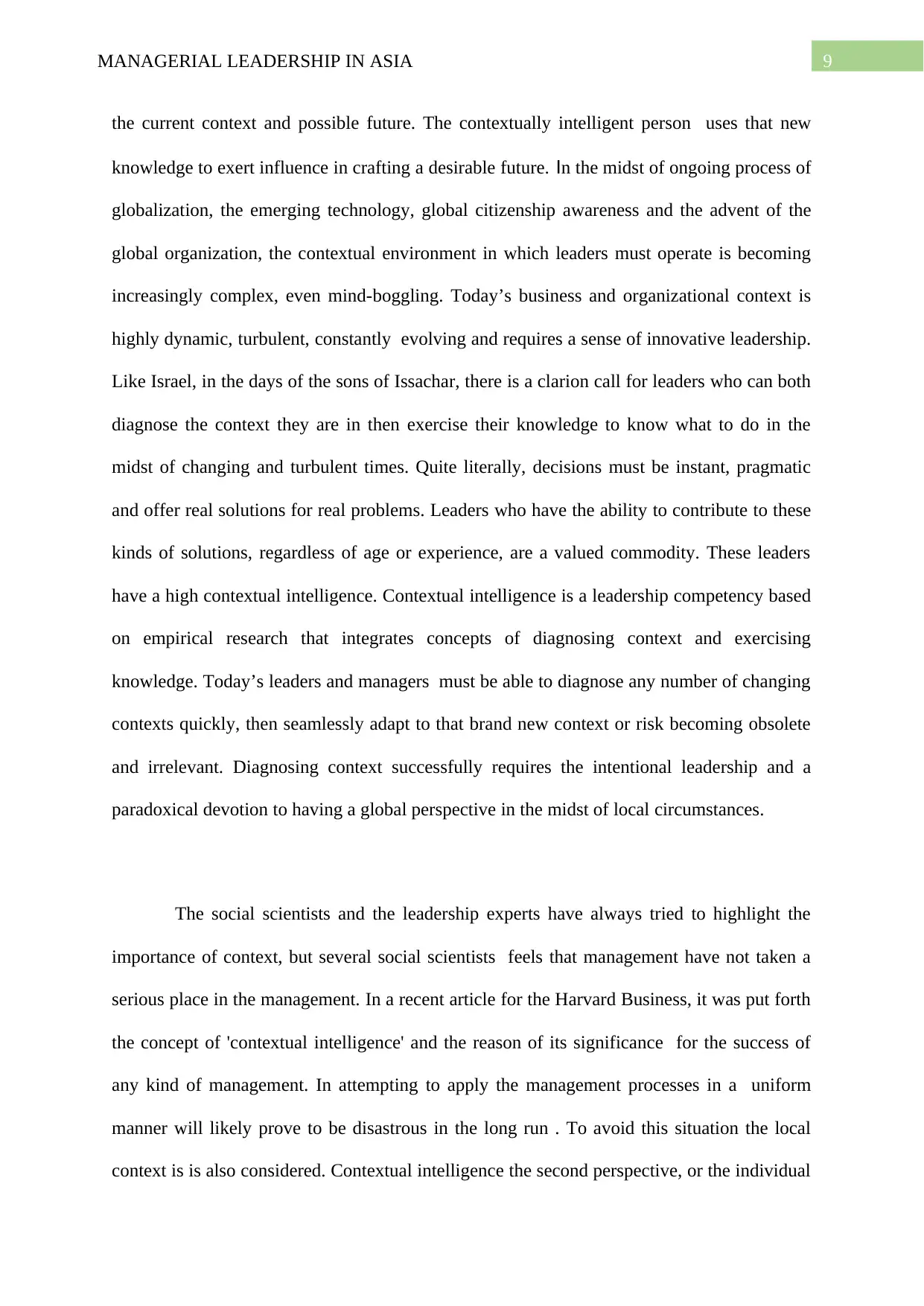
9MANAGERIAL LEADERSHIP IN ASIA
the current context and possible future. The contextually intelligent person uses that new
knowledge to exert influence in crafting a desirable future. In the midst of ongoing process of
globalization, the emerging technology, global citizenship awareness and the advent of the
global organization, the contextual environment in which leaders must operate is becoming
increasingly complex, even mind-boggling. Today’s business and organizational context is
highly dynamic, turbulent, constantly evolving and requires a sense of innovative leadership.
Like Israel, in the days of the sons of Issachar, there is a clarion call for leaders who can both
diagnose the context they are in then exercise their knowledge to know what to do in the
midst of changing and turbulent times. Quite literally, decisions must be instant, pragmatic
and offer real solutions for real problems. Leaders who have the ability to contribute to these
kinds of solutions, regardless of age or experience, are a valued commodity. These leaders
have a high contextual intelligence. Contextual intelligence is a leadership competency based
on empirical research that integrates concepts of diagnosing context and exercising
knowledge. Today’s leaders and managers must be able to diagnose any number of changing
contexts quickly, then seamlessly adapt to that brand new context or risk becoming obsolete
and irrelevant. Diagnosing context successfully requires the intentional leadership and a
paradoxical devotion to having a global perspective in the midst of local circumstances.
The social scientists and the leadership experts have always tried to highlight the
importance of context, but several social scientists feels that management have not taken a
serious place in the management. In a recent article for the Harvard Business, it was put forth
the concept of 'contextual intelligence' and the reason of its significance for the success of
any kind of management. In attempting to apply the management processes in a uniform
manner will likely prove to be disastrous in the long run . To avoid this situation the local
context is is also considered. Contextual intelligence the second perspective, or the individual
the current context and possible future. The contextually intelligent person uses that new
knowledge to exert influence in crafting a desirable future. In the midst of ongoing process of
globalization, the emerging technology, global citizenship awareness and the advent of the
global organization, the contextual environment in which leaders must operate is becoming
increasingly complex, even mind-boggling. Today’s business and organizational context is
highly dynamic, turbulent, constantly evolving and requires a sense of innovative leadership.
Like Israel, in the days of the sons of Issachar, there is a clarion call for leaders who can both
diagnose the context they are in then exercise their knowledge to know what to do in the
midst of changing and turbulent times. Quite literally, decisions must be instant, pragmatic
and offer real solutions for real problems. Leaders who have the ability to contribute to these
kinds of solutions, regardless of age or experience, are a valued commodity. These leaders
have a high contextual intelligence. Contextual intelligence is a leadership competency based
on empirical research that integrates concepts of diagnosing context and exercising
knowledge. Today’s leaders and managers must be able to diagnose any number of changing
contexts quickly, then seamlessly adapt to that brand new context or risk becoming obsolete
and irrelevant. Diagnosing context successfully requires the intentional leadership and a
paradoxical devotion to having a global perspective in the midst of local circumstances.
The social scientists and the leadership experts have always tried to highlight the
importance of context, but several social scientists feels that management have not taken a
serious place in the management. In a recent article for the Harvard Business, it was put forth
the concept of 'contextual intelligence' and the reason of its significance for the success of
any kind of management. In attempting to apply the management processes in a uniform
manner will likely prove to be disastrous in the long run . To avoid this situation the local
context is is also considered. Contextual intelligence the second perspective, or the individual
Paraphrase This Document
Need a fresh take? Get an instant paraphrase of this document with our AI Paraphraser
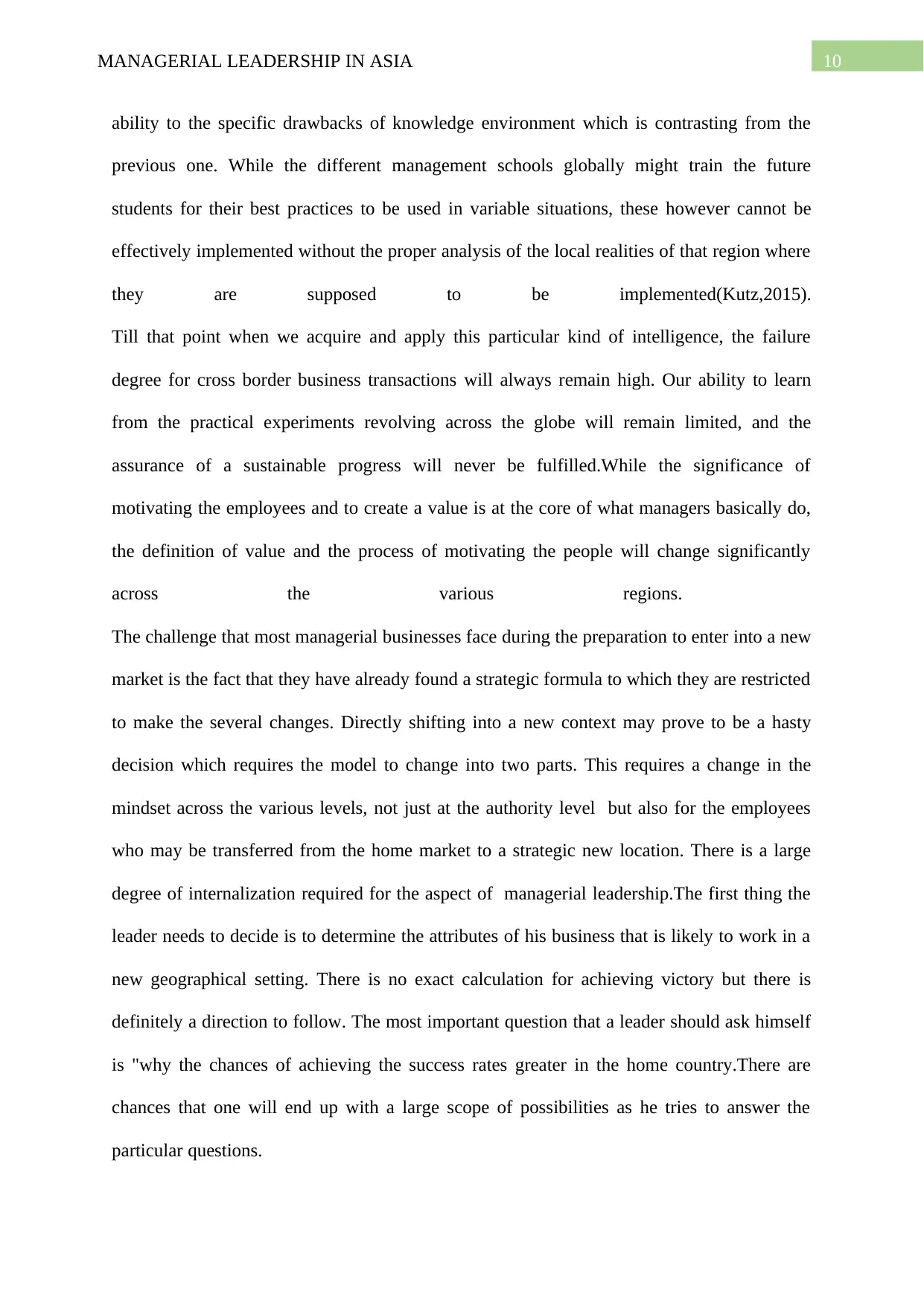
10MANAGERIAL LEADERSHIP IN ASIA
ability to the specific drawbacks of knowledge environment which is contrasting from the
previous one. While the different management schools globally might train the future
students for their best practices to be used in variable situations, these however cannot be
effectively implemented without the proper analysis of the local realities of that region where
they are supposed to be implemented(Kutz,2015).
Till that point when we acquire and apply this particular kind of intelligence, the failure
degree for cross border business transactions will always remain high. Our ability to learn
from the practical experiments revolving across the globe will remain limited, and the
assurance of a sustainable progress will never be fulfilled.While the significance of
motivating the employees and to create a value is at the core of what managers basically do,
the definition of value and the process of motivating the people will change significantly
across the various regions.
The challenge that most managerial businesses face during the preparation to enter into a new
market is the fact that they have already found a strategic formula to which they are restricted
to make the several changes. Directly shifting into a new context may prove to be a hasty
decision which requires the model to change into two parts. This requires a change in the
mindset across the various levels, not just at the authority level but also for the employees
who may be transferred from the home market to a strategic new location. There is a large
degree of internalization required for the aspect of managerial leadership.The first thing the
leader needs to decide is to determine the attributes of his business that is likely to work in a
new geographical setting. There is no exact calculation for achieving victory but there is
definitely a direction to follow. The most important question that a leader should ask himself
is "why the chances of achieving the success rates greater in the home country.There are
chances that one will end up with a large scope of possibilities as he tries to answer the
particular questions.
ability to the specific drawbacks of knowledge environment which is contrasting from the
previous one. While the different management schools globally might train the future
students for their best practices to be used in variable situations, these however cannot be
effectively implemented without the proper analysis of the local realities of that region where
they are supposed to be implemented(Kutz,2015).
Till that point when we acquire and apply this particular kind of intelligence, the failure
degree for cross border business transactions will always remain high. Our ability to learn
from the practical experiments revolving across the globe will remain limited, and the
assurance of a sustainable progress will never be fulfilled.While the significance of
motivating the employees and to create a value is at the core of what managers basically do,
the definition of value and the process of motivating the people will change significantly
across the various regions.
The challenge that most managerial businesses face during the preparation to enter into a new
market is the fact that they have already found a strategic formula to which they are restricted
to make the several changes. Directly shifting into a new context may prove to be a hasty
decision which requires the model to change into two parts. This requires a change in the
mindset across the various levels, not just at the authority level but also for the employees
who may be transferred from the home market to a strategic new location. There is a large
degree of internalization required for the aspect of managerial leadership.The first thing the
leader needs to decide is to determine the attributes of his business that is likely to work in a
new geographical setting. There is no exact calculation for achieving victory but there is
definitely a direction to follow. The most important question that a leader should ask himself
is "why the chances of achieving the success rates greater in the home country.There are
chances that one will end up with a large scope of possibilities as he tries to answer the
particular questions.
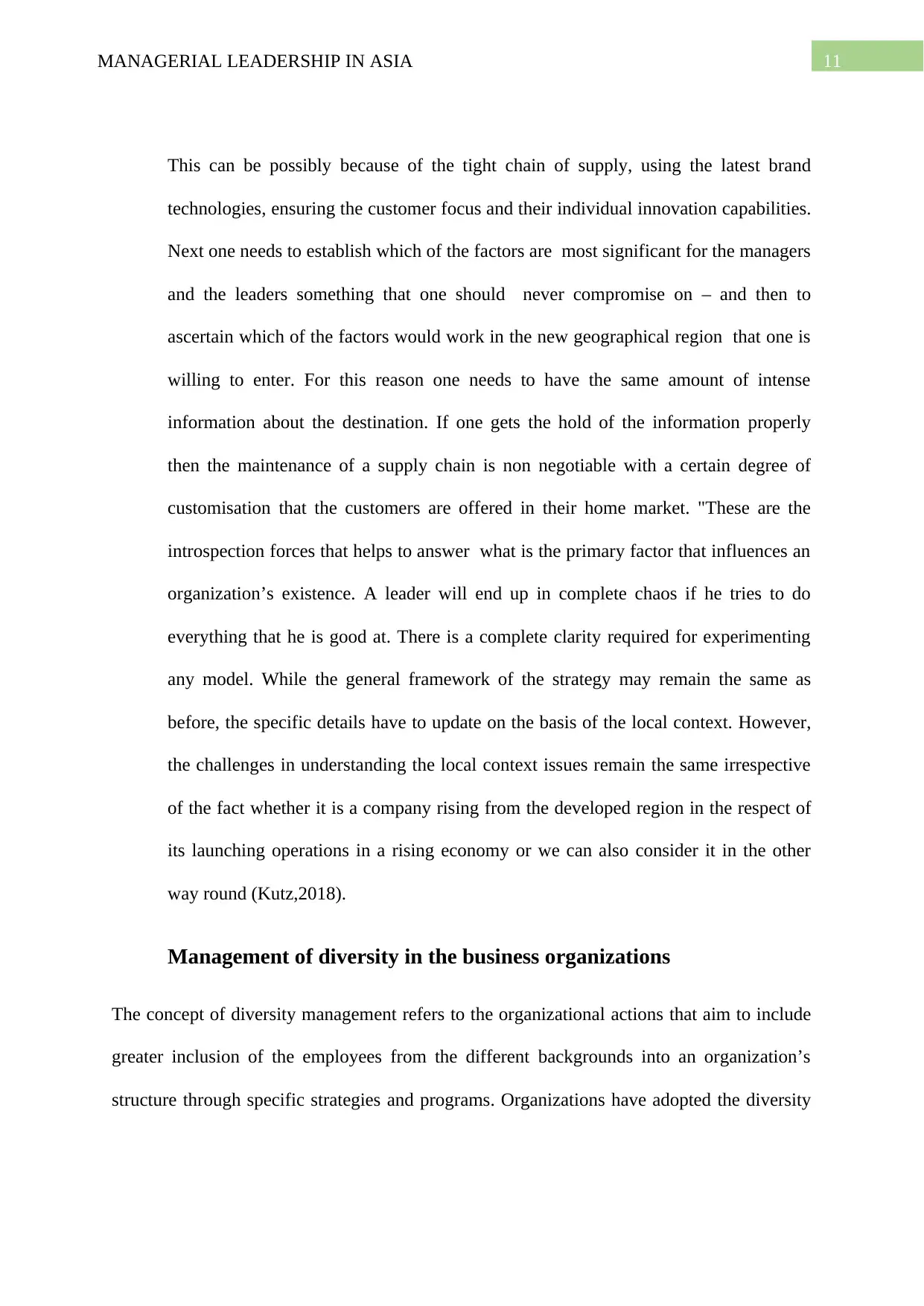
11MANAGERIAL LEADERSHIP IN ASIA
This can be possibly because of the tight chain of supply, using the latest brand
technologies, ensuring the customer focus and their individual innovation capabilities.
Next one needs to establish which of the factors are most significant for the managers
and the leaders something that one should never compromise on – and then to
ascertain which of the factors would work in the new geographical region that one is
willing to enter. For this reason one needs to have the same amount of intense
information about the destination. If one gets the hold of the information properly
then the maintenance of a supply chain is non negotiable with a certain degree of
customisation that the customers are offered in their home market. "These are the
introspection forces that helps to answer what is the primary factor that influences an
organization’s existence. A leader will end up in complete chaos if he tries to do
everything that he is good at. There is a complete clarity required for experimenting
any model. While the general framework of the strategy may remain the same as
before, the specific details have to update on the basis of the local context. However,
the challenges in understanding the local context issues remain the same irrespective
of the fact whether it is a company rising from the developed region in the respect of
its launching operations in a rising economy or we can also consider it in the other
way round (Kutz,2018).
Management of diversity in the business organizations
The concept of diversity management refers to the organizational actions that aim to include
greater inclusion of the employees from the different backgrounds into an organization’s
structure through specific strategies and programs. Organizations have adopted the diversity
This can be possibly because of the tight chain of supply, using the latest brand
technologies, ensuring the customer focus and their individual innovation capabilities.
Next one needs to establish which of the factors are most significant for the managers
and the leaders something that one should never compromise on – and then to
ascertain which of the factors would work in the new geographical region that one is
willing to enter. For this reason one needs to have the same amount of intense
information about the destination. If one gets the hold of the information properly
then the maintenance of a supply chain is non negotiable with a certain degree of
customisation that the customers are offered in their home market. "These are the
introspection forces that helps to answer what is the primary factor that influences an
organization’s existence. A leader will end up in complete chaos if he tries to do
everything that he is good at. There is a complete clarity required for experimenting
any model. While the general framework of the strategy may remain the same as
before, the specific details have to update on the basis of the local context. However,
the challenges in understanding the local context issues remain the same irrespective
of the fact whether it is a company rising from the developed region in the respect of
its launching operations in a rising economy or we can also consider it in the other
way round (Kutz,2018).
Management of diversity in the business organizations
The concept of diversity management refers to the organizational actions that aim to include
greater inclusion of the employees from the different backgrounds into an organization’s
structure through specific strategies and programs. Organizations have adopted the diversity
⊘ This is a preview!⊘
Do you want full access?
Subscribe today to unlock all pages.

Trusted by 1+ million students worldwide
1 out of 19
Related Documents
Your All-in-One AI-Powered Toolkit for Academic Success.
+13062052269
info@desklib.com
Available 24*7 on WhatsApp / Email
![[object Object]](/_next/static/media/star-bottom.7253800d.svg)
Unlock your academic potential
Copyright © 2020–2025 A2Z Services. All Rights Reserved. Developed and managed by ZUCOL.





